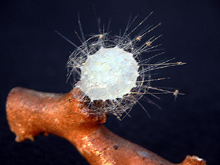
Living structures such as this glass sponge, are found at a depth of more than 1,500 ft on the northern and southern deep Lophelia reefs. Photo credit: Liz Baird. Click image for larger view.
As Close to a Fish as I’ll Ever Be
August 23, 2003
Doni Angell, Educator-at-sea
Heritage Middle School, Valdese, NC
My heart was pounding; my palms were sweating. I had a queasy feeling permeating my entire body, and it was getting worse by the minute. All this and I still had more than an hour before “the dive.” Then it happened: the call over the ship’s intercom for the pre-dive meeting in the lounge. With great trepidation, I joined the sub pilots, engineers, and congregation of scientists to get the lowdown on dive #3427. Before I knew it, I was climbing through the sub’s rear hatch into the tiny, cozy, aft compartment. Jim, the submersible co-pilot, soon followed, and the hatch was closed.
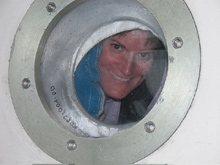
Doni Angell, Educator-at-sea, seated inside the stern compartment of the JSL II submersible. Photo credit: Liz Baird. Click image for larger view.
Instantly, any twinges of potential claustrophobia vanished, my body regained its composure, and I was anxious to get under way.
The message to the fore compartment, “We’ve got a seal,” made me wonder if first-time astronauts share my feelings of excitement when they hear the similar “Houston, we have lift-off.” Once we were off, descending to a final depth of 1,400 ft, the contrast from the "real world” was startling. At no time is it ever quiet aboard ship. The engines run constantly; A/C units blast arctic air; the deck crew engages in welding, cleaning, and making repairs; the scientists haul gear or discuss the latest findings; waves crash into the ship and each other. At times, the noise can be deafening.
The sub is different. Instantly, you are plunged into a surreal world of tranquility. No sounds. Eventually, only darkness. Then the sub’s lights kick on and you realize you’re in a fishbowl, with the ocean’s inhabitants staring at you with intrigue, or perhaps only fear. You’re in their world now. The only reminder of life up top is the scientist’s voice through your headphones, as it records the names of observed species along with the time and location. Then the whir of the electric motor speaks up, and you glide through a magical undersea Shangri-La. I feel disconnected, not wanting to ruin the peace with any talk, so I opt to sketch the creatures that I do not recognize. An African proverb teaches that “Even if you sit on the bottom of the sea, you cannot be a fish.” That may be true, but I have come as close to feeling like one as I ever will. And for that, I am truly grateful.
I was asked to write a reaction paper regarding my experiences with the “Life on the Edge" expedition. It’s hard to know where to begin, as I continue to experience the immensity and power of the ocean and the people who are dedicated to its study. In 1854, Matthew Fontaine Maury wrote: “The wonders of the sea are as marvelous as the glories of the heavens, and they proclaim, in songs divine, that they too are the work of holy fingers.” I cannot attest to heaven, but neither can I imagine a grander feeling than that which the seas have bestowed on me these past couple of weeks.
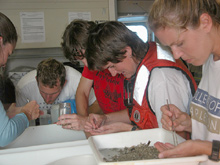
Doni contributes to the teamwork by helping out in the wet lab, sorting specimens from a Tucker trawl tow. Click image for larger view.
I am a teacher. It is a profession I chose willingly, not a career I am simply “falling back on.” In my classes, I stress that there are many ways to approach and solve problems; different individuals have different skills and opinions to offer. This involves teamwork and the ability to communicate ideas and thoughts, solutions and problems.
What I have witnessed and experienced first-hand since our departure from Charleston is teamwork of unparalleled dimensions. Researchers and crew members with various backgrounds and skills have worked toward a common goal, in tight quarters, in a true display of cooperation. In our modern world, where success is usually measured in monetary terms, and where, since grade school, competition to be the best is strongly encouraged, it is rare and refreshing to witness the modesty these people have, and the teamwork that I have been privileged to be part of. These individuals are passionate about their work and have inspired me as much as the ocean itself.
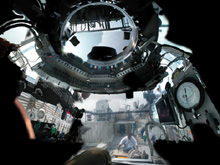
View from inside the "bubble" of the JSL II looking onto the R/V Seward Johnson's back deck. Photo credit: Art Howard, NAPRO. Click image for larger view.
The ship and its wide array of sophisticated equipment have been mind-boggling. Most anything one might desire in a land-based operation is available on board. The ship is truly its own floating city, as it needs to be, since the neighborhood hardware store is hardly right around the corner! I am surrounded by the latest in fiber- optics, lasers, sonar, Doppler equipment, and other sensors and meters and computer technology -- not to mention the winches, cables, engines, remotely operated vehicle (ROV) and manned submersible! The ocean and its waves, mustering strength as if on cue from some unspoken command, touch me most profoundly, though.
Realizing that the goals of this mission center on the life that exists on the edge of the continental shelf, I am enthralled by that which allows this existence: the water itself. The hues of the ocean rival any great artist’s palette. The shades of blue, alive and vibrant with their mesmerizing subtleties, remind me of the multi-hued greens of the tropics -- infinite changes, impossible to describe. As striking as the subtle color differences is the water’s clarity. Though human eyes are far more limiting than the ocean’s photic zone, it nevertheless appears that one can see, and thus reach, great depths -- if one only tries.
The boundlessness of the ocean is hard to fathom; its depths hide the mysteries it holds.
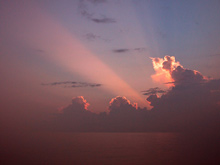
A sunrise off the bow of the R/V Seward Johnson. Photo credit: Art Howard, NAPRO. Click image for larger view.
Why, then, do we continue to spend so much on space exploration, yet largely ignore 97% of the water on Earth -- a world to which we remain largely strangers? In Twenty Thousand Leagues Under the Sea, Jules Verne wrote: “The ocean . . . offered us an incessant and infinite display of its most marvelous treasures.” I’ve been truly blessed with this opportunity to witness the display.





















